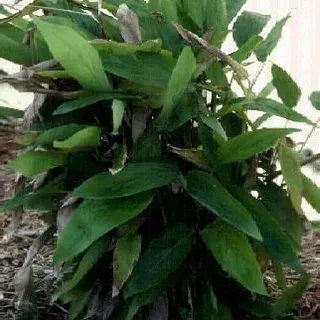Arrowroot—Maranta arundinacea L.1
Arrowroot seems to be an all-inclusive name applied to several species of plants whose roots (rhizomes) are either eaten fresh or made into flour. It is open to speculation whether the name comes from the pointed shape of the root or the belief that it cured arrow injuries. The term arrowroot applies both to the flour and the plant. Arrowroot is also called bamboo tuber, although it is not a true bamboo.

Credit: James M. Stephens
The main arrowroot of commerce is West Indian, reed, or Bermuda arrowroot (M. arundinacea). There are several varieties, distinguished as red or white, of which the red are most esteemed. The plant is of South American and West Indian origin. Purple arrowroot (Canna edulis) has been grown in Queensland, Australia, with yields of 5–10 tons of tubers per acre.
Many species of Canna have edible tubers or starch may be extracted from them. These include brick canna (C. discolor), Inca arrowroot (C. languinosa), Andean canna (C. paniculata), broad-leaved canna (C. latifolia), iris canna (C. iridiflora), and Mexican canna (C. glouca).
Arrowroot-like substances are derived from a member of the ginger family, the genus Curcuma. East Indian arrowroot, also called Tibur starch, comes from C. angustifolia; another source is C. leuchorrhiza. False arrowroot (C. pierreana) is cultivated in Indochina, and the Indonesian variety is C. xanthorrhiza. South sea arrowroot is a product of the salep plant (Tacca pinnatifida), which is poisonous until cooked. Finally, Hawaii arrowroot is derived from Tacca hawaiiensis.
Description
Many of the plants in the arrowroot group are somewhat similar in appearance. They have underground rhizomes, or tubers, from which arise reed-like, erect stems. Flat, long, pointed leaves are attached in a sheath-like fashion up and down the upright stems in typical canna or ginger-like fashion.
Culture
The starchy rhizomes of true arrowroot, M. arundinacea, are long, pointed, and enclosed with bracts. It is propagated by tubers or suckers planted 6 inches deep and spaced 15 inches apart in furrows 30 inches apart. Arrowroot should be planted at a time when it will have 10 to 11 months of hot, moist weather to mature. Under these conditions, yields of 4–6 tons per acre can be expected. Tubers are reported to contain 12% dry arrowroot (flour) and 1.7% protein.
Potential for Production
Although arrowroot is grown to a very limited extent in south Florida, very little information has been gathered concerning this crop's growth responses and possibilities here. In Gainesville, top growth was fair, but root growth was not evaluated.



